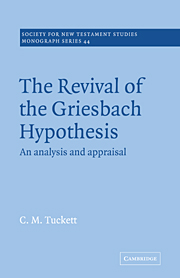Book contents
- Frontmatter
- Contents
- Acknowledgements
- Note on Abbreviations
- Introduction
- Part I Some Aspects of the History of the Study of the Synoptic Problem
- Part II General Phenomena
- Part III Some Particular Texts
- SECTION A SELECTED MARKAN PASSAGES: Introduction
- 9 The Healing of the Man with the Withered Hand
- 10 The Synoptic Tradition on Uncleanness
- 11 The Cleansing of the Temple
- 12 Tribute to Caesar
- 13 The Double Commandment of Love
- 14 The Woes against the Scribes and Pharisees
- 15 The Widow's Mites
- SECTION B THE DOUBLE TRADITION: Introduction
- 16 Wisdom Motifs in the Double Tradition
- 17 The Apocalyptic Discourses
- Conclusion
- Appendix
- Notes
- Abbreviations
- Bibliography
- Index
9 - The Healing of the Man with the Withered Hand
from Part III - Some Particular Texts
Published online by Cambridge University Press: 18 January 2010
- Frontmatter
- Contents
- Acknowledgements
- Note on Abbreviations
- Introduction
- Part I Some Aspects of the History of the Study of the Synoptic Problem
- Part II General Phenomena
- Part III Some Particular Texts
- SECTION A SELECTED MARKAN PASSAGES: Introduction
- 9 The Healing of the Man with the Withered Hand
- 10 The Synoptic Tradition on Uncleanness
- 11 The Cleansing of the Temple
- 12 Tribute to Caesar
- 13 The Double Commandment of Love
- 14 The Woes against the Scribes and Pharisees
- 15 The Widow's Mites
- SECTION B THE DOUBLE TRADITION: Introduction
- 16 Wisdom Motifs in the Double Tradition
- 17 The Apocalyptic Discourses
- Conclusion
- Appendix
- Notes
- Abbreviations
- Bibliography
- Index
Summary
This is one of the pericopes where Longstaff finds a pattern of ‘alternating agreement’. In the discussion of Longstaff's book, it was suggested that such a pattern is not only not surprising, but that it is the inevitable result of his method of analysing the texts. However, even Longstaff's detailed decisions are questionable. It was pointed out previously (and by Longstaff himself) that there are some disagreements between Mark and each of the other two gospels, and that even when Mark is (allegedly) closer to Matthew in verses 1–2, there are still twelve disagreements. Longstaff claims that these are far less significant than the disagreements between Mark and Luke, even if they are more in number (twelve as opposed to eight). However, there is a very great difference between Matthew and Mark in these two verses in the way they end: Mark has Jesus' opponents silently watching, whereas Matthew has them explicitly asking Jesus if it is legal to heal on the Sabbath. The result is that the shapes of the two accounts are now widely different. In Mark, Jesus' call to the sick man is an act out of the blue, and the saying about doing good on the Sabbath (verse 4) is a polemical assertion. In Matthew, Jesus argues his case, and concludes with the saying about doing good, which answers the initial question about legality; with this firmly established, the healing now follows.
- Type
- Chapter
- Information
- Revival Griesbach Hypothes , pp. 96 - 102Publisher: Cambridge University PressPrint publication year: 1983

